I do everything I can to take really good care of my teeth – brushing, flossing, regular dental cleanings, and avoiding sticky, sugary candy and soda. Bad teeth and gum health are linked to all sorts of health issues. Not taking care of your mouth can even affect your cardiovascular system, possibly leading to clogged arteries and strokes. So taking care of your teeth is more important than just having a gleaming white smile – which is an awesome bonus of course.
When it comes to toothpaste, I’ve tried many different brands and switched it up a lot over the years as I learn more about the ingredients that are allowed for use in cosmetics and personal care products. This is especially the case when it comes to toothpaste, as this is something that we are putting in our mouth at least twice a day and even if we don’t swallow it, the mouth is one of the most absorbent parts of the body. Essentially, whatever is in your toothpaste is getting a free pass into your bloodstream – and once you see the types of chemicals that you’ve been brushing your teeth with, you might start to think twice about the brand you’ve been buying.
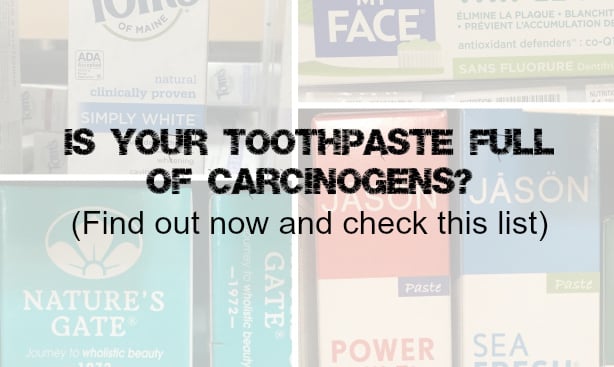
If you thought the processed food industry was bad, cosmetics are even worse!
The cosmetic industry, which toothpaste is part of, is one of the least regulated industries in the U.S.
Just like our food, they’ve been bastardized in America with ingredients that are banned overseas and self-regulated by the industry. They don’t even need to list all the ingredients on the label! It’s pretty scary and disgusting what some cosmetic companies are getting away with while raking in billions of dollars.
Don’t believe for one minute that the FDA is protecting you from toxic ingredients in your toothpaste – in fact they are part of the problem!
Case in point: Colgate has been selling “Colgate Total” for nearly 2 decades – and the FDA has just now FINALLY gotten around to banning its active ingredient triclosan… from hand and body soaps… but NOT from toothpaste.
The FDA says it is not okay to wash our hands with triclosan and rinse it off, but it’s perfectly safe to put in our mouth??? That makes no sense and some dentists are calling them out too. Why are they protecting Colgate – the only brand approved to sell toothpaste with triclosan? The FDA is clearly not watching out for consumers and are more interested in protecting the bottom line of some big corporations.
If the FDA isn’t protecting us, how do we know our toothpaste is safe?
If you’ve read the list of ingredients on a box of toothpaste lately, you’ll know that it takes a lot of research to seek out the safest brands. Even if you’ve become an expert food label reader, the ingredients in toothpaste are a whole new animal! You can’t trust the claims like “Natural” the package either, since anyone can just slap that on a toothpaste box.
That’s why I often rely on EWG’s Skin Deep Database to help me pick out safe products – and the nonprofit watchdog group Cornucopia Institute just came out with a Toothpaste Report and Scorecard, ranking toothpaste brands from best to worst, which I found very helpful… and it’s got some BIG surprises!
Check your toothpaste for these hazardous ingredients:
Artificial colors: Toothpaste can contain colors that are considered too toxic for food. The main colors I found in toothpaste were Red #30, Red #33, Blue #1, Yellow #5 – and the brands targeting children are almost always brightly colored! Made from petroleum, these artificial colors are contaminated with carcinogens and can also contain heavy metals, such as lead, mercury, and arsenic. Do you really care what color your toothpaste is?
Carrageenan: This additive is linked to intestinal inflammation and cancer, even in small doses! According to Cornucopia, “there is no restriction on the amount of carcinogenic poligeenan in the grade of carrageenan used in toothpastes”.
DEA (diethanolamine): This foaming agent interacts with other common ingredients in toothpaste to form nitrosamines, which are strongly linked to cancer in humans. You’ll even find this one in some “natural” toothpastes!
Formaldehyde-Releasing Preservatives: There is a long list of toothpaste preservatives that release small amounts of formaldehyde right into your mouth. This carcinogen is easily absorbed through the mucosal lining of the mouth. Europe and Canada have strong restrictions on formaldehyde, but that’s not the case in the U.S.! No one is checking toothpastes to see how much formaldehyde they contain, companies are not required to test them for formaldehyde and aren’t even required to disclose to customers that it might be in their product. Preservatives to watch out for on the label: DMDM hydantoin, diazolidinyl urea, imidazolidinyl urea, polyoxymethylene urea, methenamine, quaternium-15, sodium hydroxymethylglycinate, 2-bromo-2-nitropropane-1,3-diol (Bromopol), 5-bromo-5-nitro-1,3 dioxane (Bronidox), and glyoxal.
GMOs: Unless it is certified organic or non-GMO verified, you might be supporting Monsanto with your toothpaste. Some GMO ingredients to look out for and the GMO crops they are usually derived from: Glycerin (GMO soy, cotton, or canola oil), Citric Acid (GMO sugar), Xanthan Gum (GMO sugar), Xylitol (GMO corn), and Lecithin (GMO soy).
Parabens: These endocrine disrupting chemicals mimic estrogen and can lead to cancer, which is why they are restricted overseas in other countries. That’s not the case in the U.S. where they are very widely used as a preservative in toothpastes, shampoos, lotions, deodorants, and cosmetics.
PEGs (polyethylene glycols) and Propylene Glycol: These ingredients make it easier for the other chemicals in toothpaste to penetrate the skin and get into your bloodstream, exposing you to more toxins. PEGs are notoriously contaminated with 1,4-dioxane (a carcinogen), and although there is a way for companies to remove this impurity from their products – many choose not to.
Sodium Lauryl Sulfate (SLS) and Sodium Laureth Sulfate (SLES): These foaming agents break down the protective lining in the mouth. SLES is another ingredient contaminated with the carcinogen 1,4-dioxane.
Should your toothpaste have Fluoride in it?
I have not personally used toothpaste with fluoride for years and have not noticed any negative affects on my teeth. It’s been drilled into us since childhood that applying fluoride to the surface of your teeth is supposed to prevent cavities – but its effectiveness is hotly disputed (sources: 1, 2, 3). Just taking a read about why two-thirds of our U.S. public water supplies are now “fortified” with manufactured fluoride (that’s riddled with arsenic) should be enough to give you pause.
Fluoride itself is highly toxic and when it accumulates in your body can lead to skeletal fluorosis, bone cancer, and thyroid disorders. New research links it to type 2 diabetes. This is a bigger risk for children who typically swallow more toothpaste than adults, where it can affect cognitive function and can cause yellow and brown stains on the teeth.
Most people in America are already getting doused with fluoride in drinking water, packaged beverages and soups (made with fluoridated tap water), and from naturally-occurring sources like nuts and fruit – you’ve got to question whether your toothpaste really needs it too or if this is just another big myth perpetuated by the chemical industry.
Popular Toothpaste brands to avoid all costs:
These toothpastes are filled with several of the toxic ingredients listed above and got the worst ratings on Cornucopia’s scorecard. The sad thing is these are the most popular ones that fill up mass-market grocery store shelves and spend big money on advertising! I’m sure many of you grew up brushing with these…
- Crest
- Colgate
- Arm and Hammer
- Plus White Whitening

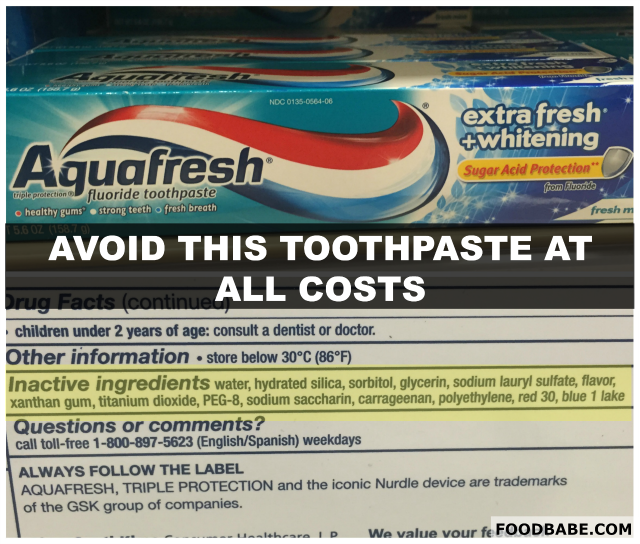
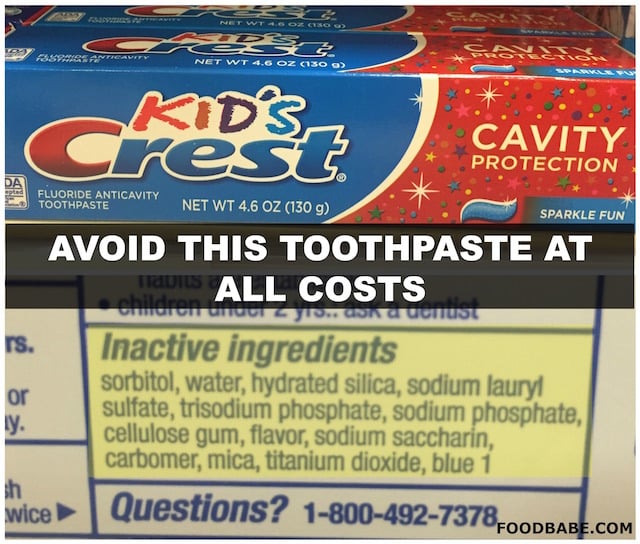

Watch out for some “natural” toothpastes too…
Desert Essence, Tom’s of Maine, Jason, Honest, Spry, Nature’s Gate and Kiss My Face toothpastes did not rank well at all… and they are sold in natural food markets everywhere. This surprised me a little bit, and I even personally have used some of these in the past when I didn’t know the risks associated with some of the ingredients. Some of these toothpastes contain carrageenan, foaming agents, possible toxic contaminants or potential GMOs.
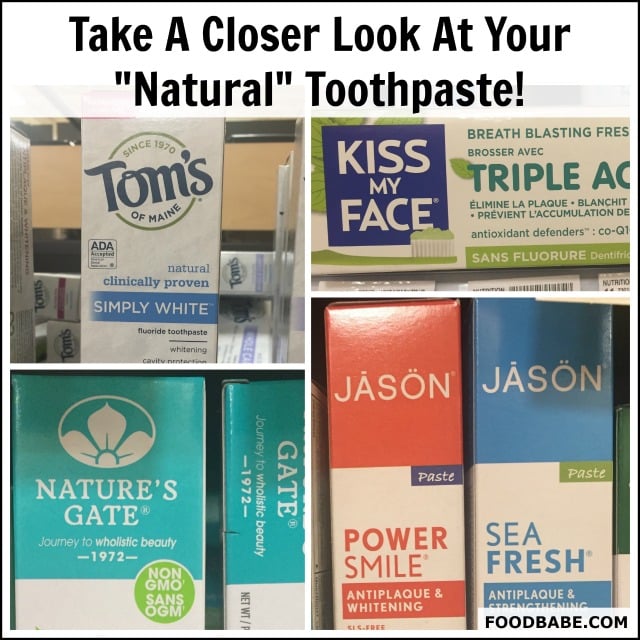
This is why ingredients in toothpaste are so important. And that’s why I made a toothpaste.
Truvani Clean Toothpaste: It’s carrageenan and fluoride free. We also removed all other weird ingredients like DEAs, formaldehyde-releasing preservatives, sodium lauryl sulfates (SLS). Just great ingredients. All the way through.
Now, you’ll notice that our toothpaste is not USDA organic. Why?
A real toothpaste requires some ingredients that can’t be organic. Like calcium carbonate. This is a compound often made from minerals from rocks… and rocks can’t be organic. But this ingredient is essential because it’s a light abrasive that can help clean teeth.
Cornucopia also provides easy recipes to make your own homemade toothpaste in their report. I haven’t personally tried to make my own, but if you have please let me know in the comments below how yours turns out!
If you have friends and family who brush their teeth with carcinogens, please share this post with them! When more people start demanding and buying safer products, companies will take notice and better options will be made available to us all.
Xo,
Vani


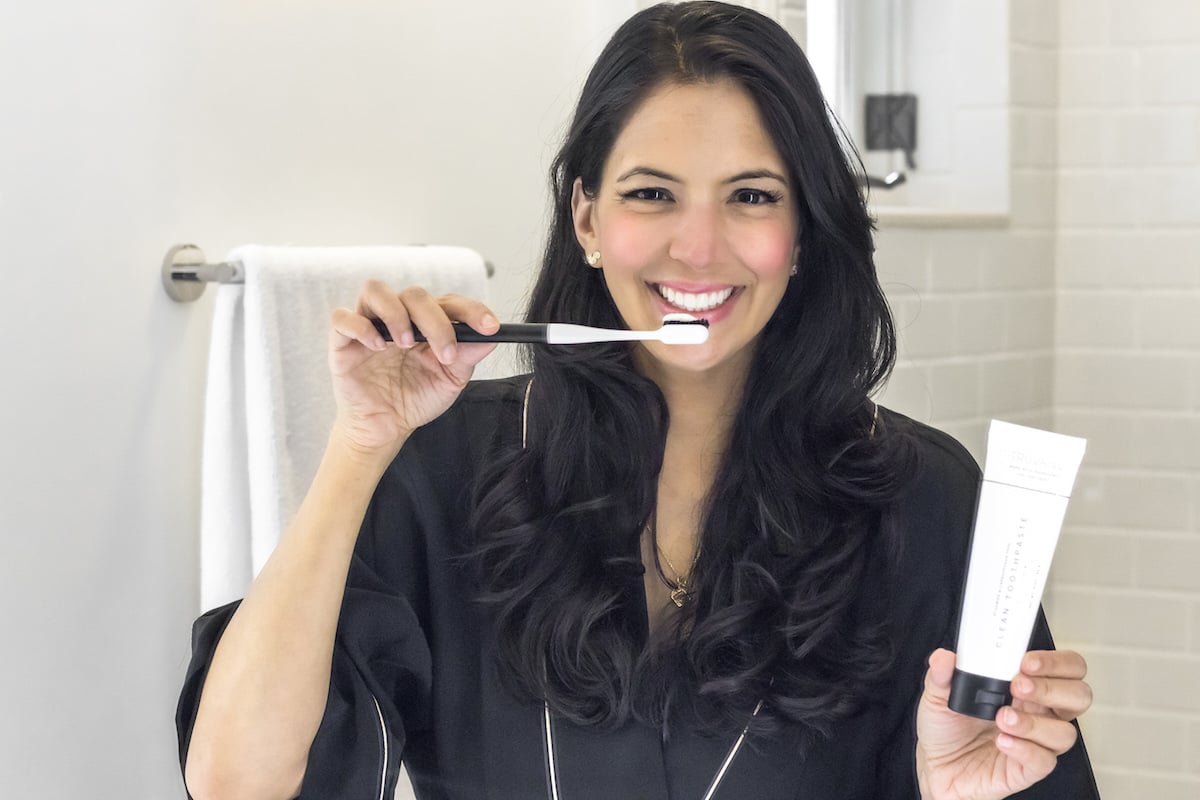






I cane down with acid reflux about 20 minutes after a floride treatment. I thought I was gonna die.
Thanks Vani. We had been using Tom’s toothpaste for kids and Trader Joe’s toothpaste, also manufactured by Tom’s. Just came back from Sprouts and got the Dr. Bronner’s peppermint toothpaste and RADIUS organic coconut banana toothpaste for kids. Add RADIUS to your list, it’s completely organic.
Thts why I buy Arbonne toothpaste, totally all natural and its awesome, doesn’t have all the yucky preservatives and it last for months and it doesn’t go bad, just takes a dallop and it’s pure minty flavor. Love love love it, no longer have bleeding gums!
I SHARED THE ARTICLE ABOUT TOOTHPASTE WITH MY DAGHTER. WE BOTH BOUGHT THE WELEDA BRAND WHICH HAS SALT IN IT FOR A VERY GOOD CLEAN..IT IS JUST LIKE WHEN I GET MY TEETH CLEANED AT THE PERIODONTIST OFFICE. THANK YOU Van for all you do
You listed Weleda. I just checked them out on Amazon, and one of the reviewers mentioned it has Xanthin Gum. I remember this as one of the stuff you mentioned should be avoided. Confused here. Would you mind looking into this?
What about Auromere Mint Free toothpaste, recommended by my Auyervedic physician.
I have very sensitive teeth and find relief from using toothpaste for sensitivity. Are there any organic brands that will help with that?
Great article! Thanks for sharing, more people need to know the dangers in the everyday household name brands. Have you tried the toothpaste line by Young Living? Another great chemical-free toothpaste is Thieves AromaBright by Young Living Essential Oils… and they have a kids toothpaste called KidScents Slique.
Hi. You mention that Xylitol is gmo. But jack and Jill toothpaste for kids is high in xylitol. Please explain. Thank you.
Gene technology
Traditionally, xylitol is produced chemically from wood sugar (xylose), which is available from wood chips produced in the paper industry. Xylose occurs in the tissue of many plants, such as birchwood, straw, corncobs and coconuts.
Additionally,glucose can be the base material for the production of xylitol. This develops in the process of starch saccharification of plant starch.
If glucose is won from maize or maize starch it may consist partly of genetically modified maize, especially when the raw materials are imported from the USA or Argentina. In the EU, genetically modified maize is grown on a comparatively small area and nonetheless is not used as raw material for foodstuff. This may change in the case that the cultivation of GM maize increases in significance.
Enzymes solubilise plant starch and metabolize it into compounds classified as ingredients and additives. Several such enzymes, such as amylases, glucose-isomerase and pullulanase, are produced with help of GM-microorganisms.
In the USA, a procedure has been developed to produce xylitol with help of GM microorganisms (Escherichia coli). The bacteria was altered in order to solubilise particular forms of plant cellulose (the structural substance of plant cells) and can produce xylitol. There is no information on the prospective commercial use of this procedure.
Labeling: starch-based additives are subject to labeling if they are directly produced from genetically modified plants (e.g. maize). It is not yet explicitly clarified whether this also applies to xylitol that results from starch and glucose respectively by way of various processing stages. In practice, it has been established that labeling is not applied.
Enzymes and their manner of production generally are not declared on the list of ingredients.
Additives that are produced in closed systems with the help of GM microorganisms are not subject to a labeling requirement, provided that the additive in question has been purified and does not contain any microorganisms.
An additive is not subject to a labeling requirement even on the case that the microorganisms used in its production have obtained nutrients (substrates) derived from GM plants.
Don’t you love it…. Triclosan is now banned in hand soap, but it is perfectly fine to stick it in your mouth
Here is a simple recipe for toothpaste you can make yourself.
1 cup of organic coconut oil
2 tps of baking soda, (make sure it is aluminum free).
a few drops of peppermint essential oil
Blend and happy brushing.
I used to use arbonne toothpaste but dentist said I needed a brand with fluoride … although at my next appointment I’m going to quiz him further
But for now, can you recommend any toothpaste that is healthy (no products mentioned in your article), with fluoride (I know it’s mentioned but till I see the dentist. …), not tested on animals and vegan … please?
Thanks
You won’t find a recommendation for toothpaste with fluoride here. There is a whole section in this article pertaining to fluoride and the fact that it is highly toxic. Please re-read the article.
What about EarthPaste? Is it a quality toothpaste? Its “supposed” to draw out toxins in the teeth as it is made with clay. Please advise.
I LOVE my Pure Haven Essentials toothpaste for all these reasons, they even make something for the little ones!
Thank you for publishing this list and information! I was wondering about toothpaste when I recently bought a new tube… And because I also needed more deodorant and found that the sick of Tom’s I looked at (antiperspirant and deodorant) had more aluminum in it than Secret! I hope you’ll do more information on deodorant soon, too.
Food Babe – I’m curious to know what you think of Uncle Harry’s toothpaste? Looks like a winner to me, but I’d love your stamp of approval! 🙂
Hi Vani, would you recommend this recipe for a healthy toothpaste?
Andrew
cup of organic coconut oil
2 tps of baking soda, (make sure it is aluminum free)
a few drops of peppermint essential oil
Thanks a lot for this! I just bought the Dr. Bronner’s and the first ingredient that stuck out to me is hydrated silica, which is known to damage enamel. I’m a little surprised cornucopia.org didn’t consider this aspect of toothpaste safety in their review. Next time I think I’m going to go with the next one on the list, Happy Teeth. I checked for ingredients on their site and they have them all listed and actually even explain the function of each ingredient. They say it’s so pure you can eat the toothpaste! Anyway, thanks for this write-up!
Hello, Julius,
You told that :
“hydrated silica, which is known to damage enamel”
Can you share the source ?
Thank you for the time
I have been following your articles for a number of years. We use only toothpastes made in India.
Namboodiri’s
Meswack
Neem without fluoride
Dabur
What is your opinion on the Indian toothpastes?
In addition, we use tooth powder from India.
Read my article in my facebook page Perinkulam Ramanathan on what Gheranda Maharishi says. Neem stick is better or using salt is good. Siddha medicine prohibits use of toothpastes altogether. Gheranda Samhita says to use Khadira plant. “The modern method of using a toothbrush cleans the teeth but not the gums.” He says use the fingers to clean the gums. He recommends dhanta moola dhauti. My email is [email protected] if you want to reply.
Real Purity Toothpaste comment : Its good that they are going for organic, but the toothpaste contains glycerin. Glycerin puts a layer on your teeth that makes it hard for the teeth to remineralize.
Crazy that the toothpaste brands we should avoid are the ones that almost everyone uses… 🙁
Another toxic chemical, which everyone thinks is benign, is titanium dioxide (nanoparticles). This is added to many toothpastes. Recent research concludes that titanium dioxide nanoparticles may lodge in the gum tissues, starting an inflammation cycle.
It’s amazing how ubiquitous titanium dioxide is but I’ve noticed titanium dioxide free make-up and cosmetics brands being launched.
Thank you for writing this! It’s a good point you made about not noticing any negative affects not using fluoride in my toothpaste.
I make my own Toothpowder called DRY- TOOTHPASTE. The brand is SENSITIVE AND FREE. I have been making and using DRY- TOOTHPASTE for 4 years!
I use only organic and food-grade ingredients. I love it and I love that it works! I’ve had positive feedback from my dentists at my regular check ups. I actually frequently swallow mine! DON’T DO THIS WITH CONVENTIONAL TOOTHPASTE. PLEASE! One day when I was sick, swallowing it had me feeling well!
It’s people like you who share about these toxins in toothpaste that help others with their health and feeling better. Thank you again, for doing it.
But your favourite pick toothpastes include xanthan gum and glycerin…
What about dr bronners toothpaste
Hi, the Cornucopia Institute link now just brings you to a page that says this: “Thank you for your interest in the Toothpaste Scorecard and Report! Cornucopia is under new leadership since this work was published. We have decided to invest our small staff resources entirely on organic food issues, including these scorecards: Eggs Dairy Beef Poultry Yogurt Snack Bars Cottage Cheese Plant-based Beverages”
It’s exasperating trying to find a good one. I’m about ready to throw my hands in the air and just use baking soda and coconut oil to brush…